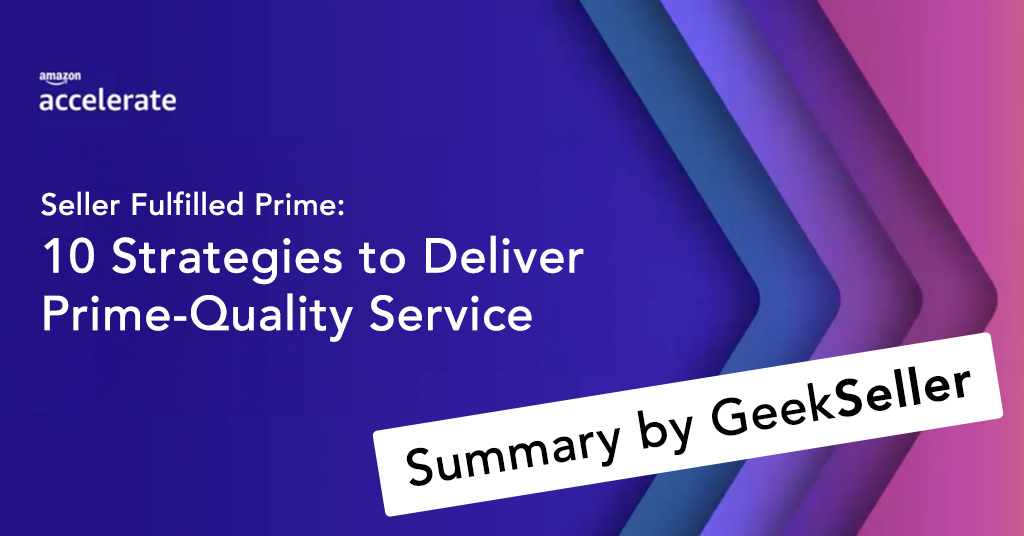Seller Fulfilled Prime (SFP) is a powerful program that allows sellers to provide the coveted Prime benefits—like fast, free shipping—while fulfilling orders from their own warehouses. However, getting started and succeeding with SFP can be challenging, especially with the stringent performance metrics and operational requirements. If you’re thinking about enrolling or improving your SFP performance, here are some key tips shared by Jenny Kim, Principal Product Manager of Seller Fulfilled Prime, from her presentation at the Amazon Accelerate conference.

1. Don’t Enroll Your Entire Catalog
Not all products are a good fit for SFP. Since Prime orders require same-day shipping, it’s essential to ensure you can meet these demands. Rather than listing your entire catalog, start with a select number of products that can be quickly processed and shipped. Evaluate your inventory and prioritize items that are easy to replenish and that have high shipping reliability.
2. Choose the Right Products for SFP
Some products are better suited for Seller Fulfilled Prime than others. Jenny emphasized that certain types of inventory, like heavy, bulky, or slow-moving goods, may benefit from being in SFP rather than Fulfilled by Amazon (FBA), where storage fees can accumulate. High-value items can also help offset premium shipping costs, and customizable products are another category that works well with SFP, as they often need to be personalized before shipping.
3. Use Multiple Warehouses to Optimize Coverage
Operating with multiple warehouses can significantly improve your SFP performance. With the requirement to ship nationwide, having more than one warehouse helps you cut shipping times and costs, especially when fulfilling orders across long distances. According to Jenny, about 60% of successful SFP sellers use two or more warehouses, allowing them to maintain fast delivery speeds and reduce the reliance on costly air shipping.
4. Pre-Package Items to Speed Up Processing
Efficiency is critical in SFP, especially since same-day shipping is a requirement for Prime orders. One way to speed up your fulfillment process is to pre-package your items so they’re ready to go as soon as an order is placed. This small adjustment can help ensure you meet the demanding SFP performance metrics and avoid penalties.
5. Monitor Your Performance Daily
Don’t wait for Amazon to notify you if you’re not meeting SFP standards. By then, it might be too late to correct course. Make it a daily habit to check how well you’re performing against key metrics like on-time shipping and valid tracking rates. Monitoring performance in real-time allows you to quickly adjust your strategy—whether that’s removing certain products from SFP or pausing Prime offers—before any issues escalate.
6. Use Multi-Location Inventory (MLI) Tools
Managing inventory across multiple warehouses and platforms can be overwhelming. To streamline this, Amazon offers tools like Multi-Location Inventory (MLI), which helps you manage inventory across different locations. By telling Amazon where your stock is located, the system can optimize delivery promises to customers, helping you meet performance requirements more effectively.
7. Optimize Carrier Communication and Pickup Times
One critical challenge for SFP sellers is ensuring carriers arrive at the right time for pickups. If a carrier shows up earlier than expected, it can disrupt your entire fulfillment process. For example, if your carrier is scheduled for 3:30 PM but arrives at 2:00 PM, orders that could have been shipped that day might be delayed until the next day. To avoid these issues, maintain clear, open communication with your carriers and ensure they adhere to the scheduled pickup times to avoid delays. Where possible, negotiate later pickup times to extend your order cutoff time and increase your daily processing capacity.
8. Manage Inventory Across Multiple Warehouses
If you operate from multiple warehouses, regularly reviewing your inventory levels and ensuring proper placement across locations is vital. This helps you balance supply, especially during peak sales periods like Prime Day or holidays. Effective inventory management can prevent stockouts and ensure you’re able to fulfill Prime orders quickly and accurately. Frequently check for low stock and strategize inventory placement across warehouses to avoid bottlenecks in any single location.
9. Set Daily Order Handling Limits
Unexpected surges in orders can overwhelm your warehouse operations, leading to late shipments and a poor customer experience. To protect both your fulfillment process and Prime eligibility, consider using Amazon’s order handling capacity settings to cap the number of Prime orders you accept daily. For instance, if your team can handle 2,000 Prime orders in a day but suddenly receives 6,000, setting a cap helps manage the overflow effectively. This proactive measure protects you from becoming overwhelmed and helps maintain consistent performance during high-demand periods
10. Use Performance Metrics and the SFP Dashboard
Tracking your Seller Fulfilled Prime performance metrics is key to staying in compliance with Amazon’s standards. The SFP dashboard allows you to monitor various performance metrics, such as speed and delivery accuracy, across different product categories and size tiers. It’s important to regularly download your speed and defect reports to pinpoint underperforming ASINs. If certain products consistently fall below the required metrics, consider temporarily or permanently removing them from Prime until you can resolve the issues. Focusing on improving your valid tracking rate, on-time delivery rate, and cancellation rate will further ensure that you maintain good standing within the SFP program.
By applying these four key tips, SFP sellers can ensure smoother fulfillment operations, protect their Prime eligibility, and deliver a better customer experience.